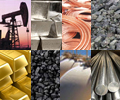
[ad_1]

A slowdown in Chinese growth rates is likely to make the Asian giant’s economy less commodities-intensive in future, putting a brake on spiraling prices and on any current “supercycle,” according to participants at the Financial Times’ Commodities Global Summit June 15.
However, a longer-term structural change in economies due to energy transition and “green spending” may yet lead a supercycle to emerge in future, possibly in the 2030s, some participants at the summit said.
“China is no longer the source of growth that it was before… and has shown that it can no longer sustain these price rises… it’s getting crushed,” said Jeff Currie, global head of commodities research, Goldman Sachs, in a panel to discuss the existence, or otherwise, of a supercycle. Commodities markets are disconnecting from China, as consumers in the US and Europe are absorbing the high prices while margins in China are weak, Currie said.
The Chinese government in recent weeks has clamped down on speculation and reported price collusion in steel and iron ore markets after prices hit record highs. S&P Global Platts assessed the 62% Fe Iron Ore Index at $222.35/dry mt CFR North China June 15, more than double its price of a year ago, and just short of an all-time peak of $233/mt on May 12. The price surge has been attributed mainly to government stimulus-backed infrastructure drives in many nations in a coronavirus pandemic recovery effort, coinciding with supply-side difficulties in Brazil and Australia.
China to become less commodities-intensive
Mark Williams, chief Asia economist, Capital Economics, told the panel that while China’s infrastructure activity is currently “a pretty substantial” 15% above pre-pandemic levels, the country’s future demand prospects for commodities aren’t particularly positive. China currently consumes more than half the world’s copper and steel supplies, and it accounts for well over half the world’s primary aluminum production, much of it based on coal-fired energy.
“We think China’s growth is going to halve over the next decade,” Williams said. “It will be less commodities-intensive in future according to its five-year plan.”
While China’s GDP growth is expected by the International Monetary Fund to recover to 8.44% this year from 2020’s 2.27%, growth is then seen gradually tapering down to 4.86% annually in 2026.
Urbanization will slow and there will be more emphasis on technological rather than infrastructure developments, Williams said.
“China has some very ambitious green targets… and it won’t be able to meet its CO2 targets if it carries on increasing its aluminum consumption,” the analyst said.
Mick Davis, CEO of mine development company Vision Blue Resources, ventured that “China might be entering troubled middle age while India remains a promise never fulfilled.”
Jumana Salaheen, chief economist and head of sustainability at CRU, said that the recent spate of strong commodities prices are “part of a normal business cycle recovery” from the pandemic, rather than a supercycle. CRU believes prices have reached their peak.
“A supercycle means prices rising for 10-35 years,” she said. There have been four recognized commodities super-cycles in the past 150 years: the period of industrialization in the 1880s, the roaring 1920s, the long period of prosperity following the Second World War and following China’s accession to the WTO in 2001, she said. There have of course been many other business cycles, Salaheen said.
Davis, “a big proponent of the supercycle,” said he believes this will occur due to the “structural change in how we live our lives moving forward,” amid the “tectonic shifts” of the green revolution.
If we take copper as a proxy he said, it’s notable that electric vehicles will require five times more copper than internal combustion engine cars, while a 3-MW wind turbine uses up to 4 mt-5 mt of copper. If EVs targets are to be met, 2.5 million mt additional production will be needed for EVs, as well as 3 million mt copper for solar power and 2 million mt for windpower by 2030, meaning copper demand will jump by 50%-80% from current levels by 2030, he said.
Decade of underinvestment in supply
“There are only 5 million EVs on the roads today but by 2040 there will be 300 million… this means a long-term sustained increase in demand, ” Davis said. Prices will rise because industry simply cannot respond, due to a decade of underinvestment, in both oil and gas and mining, he said. “Eventually there will be a prodigious supply response but not any time soon and certainly not within this investment horizon.”
LME cash copper prices closed at $9,900/mt June 14, close to an all-time high and nearly double the $5,646/mt of a year ago.
The idea that the industry will deliver significant amounts of copper over the next few years is a “delusion,” said Davis, also noting that since 2015 there has also been only one significant discovery of reserves of cobalt, another mineral considered crucial to the success of the EVs revolution.
‘Bullish’ on oil
Questioned on whether it’s possible to have a supercycle without oil, Currie said Goldman Sachs is very bullish on oil, seeing it rising from just over $70/b today to $80/b or above in Q3, and not ruling out a short to medium-term $100/b price.
“The oil price will benefit from green capex spend” because there will be a reduction of supply, Currie said, drawing a parallel with prices for tobacco and coal prices which have risen since moves started to curb their usage.
Source:Platts
[ad_2]
This article has been posted as is from Source